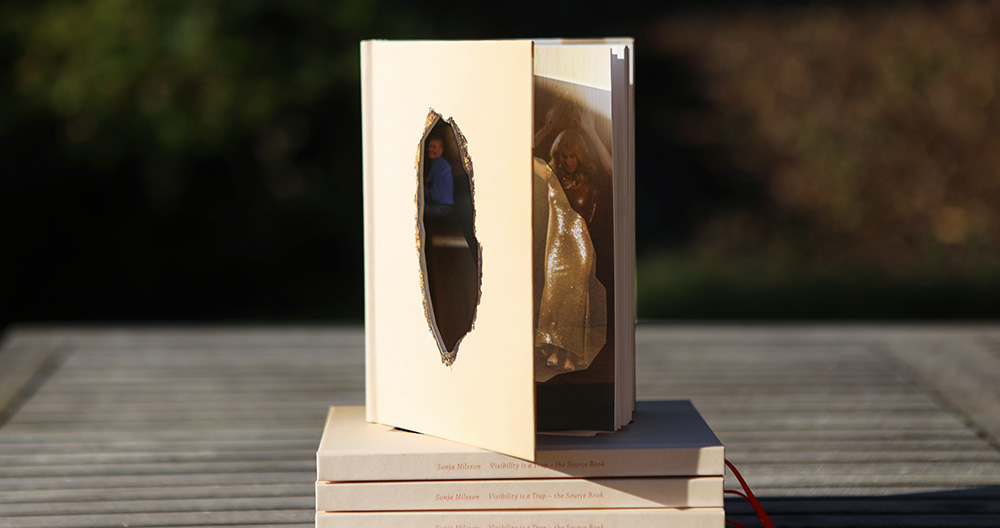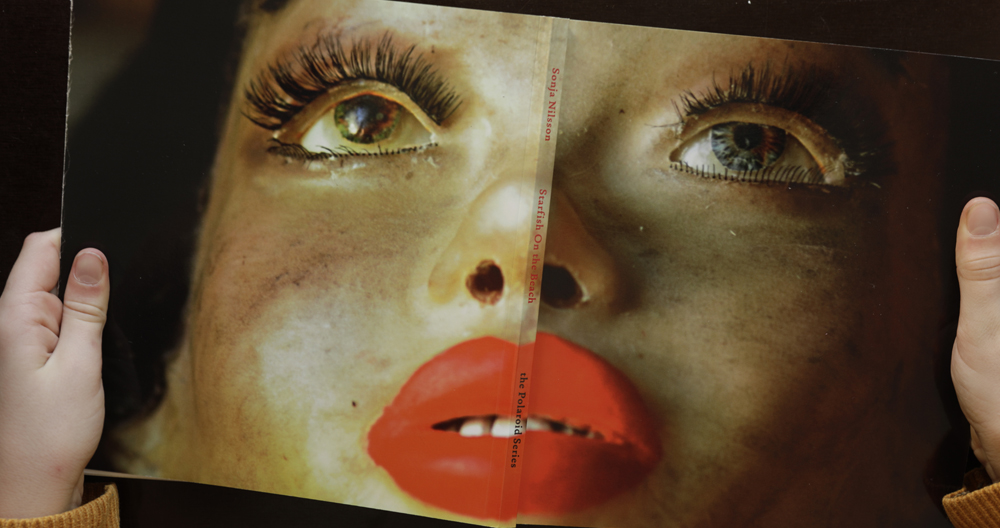Visibility is a Trap - the Source Book can be ordered here:
Germany:
Motto
Sweden:
Konst/ig Books
Or buy direct from me. 15 EUR inkl shipping worldwide!
Send me an email

Starfish On the Beach - the Polaroid Series (sold out)

////////////////////////////////////////////////////////////////////////////////
Performance "Approaching Numinosity" at Meeting Point in Gävle, September 3, 2024
////////////////////////////////////////////////////////////////////////////////
Performance at Ôcken • Stocksbo Kulturhus, March 23, 2024
////////////////////////////////////////////////////////////////////////////////
Introductory text for the exhibition Starfish On the Beach at Galleri Rostrum, Malmö 2023
The project for this show was done with support from Konstnärsnämnden, The Swedish Arts Grants Committee.
////////////////////////////////////////////////////////////////////////////////
Video documentation illustrating the sound and photo installation from the piece /ˈdaɪ.ɪŋ/ at Heit, Berlin 2021
The project for this show was done with support from Konstnärsnämnden, The Swedish Arts Grants Committee.
////////////////////////////////////////////////////////////////////////////////
A few lines of introductory text for the exhibition at Österängens Konsthall, Jönköping Sweden 2019
The exhibition consists of a video installation with six scenes where a number of characters meet and end up in conversations, discussions, quarrels and even in a jam session.
////////////////////////////////////////////////////////////////////////////////
Excerpts from the exhibition catalog, The Verket Art Institute’s Summer Exhibition in Avesta, 2015, text by Karin Perers
"See me, be Her", is about the capacity to personify and
////////////////////////////////////////////////////////////////////////////////
excerpt from an interview to the exhibition catalog "Collected Works! 30 years with the Maria Bonnier Dahlin Foundation", Bonniers Konsthall, Stockholm 2016 (translated from Swedish)
////////////////////////////////////////////////////////////////////////////////
An introduction in my words from the Liljevalch’s exhibition catalog "Death, an exhibition about life", 2016
How would I like to be buried? I quickly and rationally surmised that when death occurs, the decision will be made by those who survive me. How would my loved ones reason? I posed the question and received the answer that my grave should contain a hologram, as this would be appropriate for me and my ingenious devices. It was, in a way, comical. For my part, I reasoned that if this is how they want it, then, of course, this is how it will be. However, the question remained – disregarding the wishes of my relatives, what would feel right for me? It was virtually impossible to think of anything that felt exciting, beautiful or tempting.
Instead, I felt only a sense of grief. Cremation felt too rational and akin to garbage disposal, modern methods such as freeze drying for composting felt as if one were on
par with a plant. And being buried in the cold, dark earth felt like being put away and forgotten.
As my thoughts began to wander I remembered an article I had read some years ago about a man who had dug up the bodies of 26 young women, mummified them and turned them into human-size puppets. For ten years he lived with them as if they were his children. He dressed them in nice, colourful clothes, talked to them, sat them in front of the television and arranged birthday parties for them.
The sadness I felt over the distance to the dead turned into a happier daydream about this place where the gap between the dead and the living has been bridged.
////////////////////////////////////////////////////////////////////////////////
In Färgfabriken’s large hall, Sonja Nilsson stages a drama in five acts. Stage sets are constructed in which the characters appear with blurred contours. Room after room appears and disappears as we proceed through the narrative.
The stage lights up:
It all began with the dream of love.
Ahaaw, love to love you baby. Ahaaw, love to love you baby.
We are in the 1970s, in the lingering era of free love. The record player is playing Donna Summer, round and round, 45 rpm. Hips swaying in time. Two girls are getting ready for adventure.
They talk of their yearnings. Of the importance of having a strategy.
Hairband or hair down?
The whole outcome depends on it.
In a bar, a Folk Singer is sitting with a few friends get- ting ready for the same kind of adventure. They talk of their yearnings. Of how they want to lay everything. Everywhere. But where do you look when your desires have reached bursting point?
The landscape of lust lies before them. The hunt for pleasure continues in a taxi. Where the Folk Singer checks out the territory. Passing prey after prey. Aims with his groin.
Bang!
There they are. Two big, dark eyes. They blink at the headlights. The Folk Singer changes his costume. Becomes a gentleman with a fumbling hand.
Here is a man who knows how a lady should be treated.
The girls scrutinise him. What is he worth? Their company?
The game continues in the Folk Singer’s apartment: Who is chasing whom? The girls bat their eyelids. They suck their fingers. The Folk Singer strums his guitar. Lavishes compliments on them. He takes aim.
But the girls are exhausted and have fallen asleep on his bed. What an opportunity! He calls his friend. He wants to share his prey. Proud and expectant.
The night moves towards dawn and the drama towards the end. The girls are fast asleep, with their hair spilling across the pillow. The Folk Singer fumbles between their legs. Seeking to complete the adventure. But his hand finds something where he had expected to find something else.
Meanwhile, his friend arrives and sees everything – a key witness. The Folk Singer first tries to defend himself:
This is not what you think, I’m not like that.
And then the attack, against the girl. A knife from the kitchen drawer. The back is stabbed by a blade. He screams, she bleeds and the scene blacks out.
—
In Sonja Nilsson’s work at Färgfabriken there is a tacit certainty that creates uncertainty on several levels. Is this the 1970s, is this 2013, or is this a primordial man in disguise we are looking at? The same humanity, different settings. The same story, different storytellers.
Or have we? When the knife is thrust into the back it is both horrific and elusive.
And at the same time so banal and predictable. A passion; love and hate.
The work plays with our expectations. Just like the characters in the drama play with each other’s expectations. Are they archetypes or humans trying to relate to archetypes? Are they sticking to their own inner scripts, are they following the script for this work, or the world’s script? We can only guess or presume. The Other is somehow always unpredictable to us. In order to work out what another person will do, we perhaps have to be that person. And not even then can we be entirely sure.
Our actions follow certain patterns. These are rarely that unexpected or random. They are repetitive, more likely. We create systems for most things, even for love. And yet, we are startled by things, big and small, almost daily. The relationship between expectation and surprise is a theme Sonja Nilsson pursues in several of her works. Is the unexpected something we, in fact, look for, or something that comes looking for us? That creeps up on us from behind? Sonja Nilsson often constructs scenarios where we pursue and are pursued by our own expectations. And by ourselves – as in the Mirror Labyrinth (2006) – a claustrophobic corridor where I see myself being seen, by myself. An eternal oscillation between expectation and realisation, between the experience and the image of the experience.
An expectation easily becomes a prejudice; a notion that governs the way we see the world around us. We have an image of someone, or of ourselves, that can be demolished at any time. Who can we blame then? Who is the villain? And who are we to judge, whom? In the work at Färgfabriken we witness an atrocity. But exactly when does it become atrocious? And when is it okay again? Nothing is smoothed out in the work, nothing is purified. The liberating fuck is absent. The adventure ends abruptly when someone sticks a knife into someone else.
What happened then?
The consequences only arise in our speculations. We are left to ourselves and our memory of what we have seen. This is a recurring element in several of Sonja Nilsson’s works; the viewer comes away with a kind of souvenir. In The Silence of the Lambs (2008), we see Sonja herself dancing in another familiar environment, the set for the movie thriller with the same title. A strong light flashes from the work and the figure of the artist is literally etched on our retina. Does that make her image ours?
At Färgfabriken we don’t get a souvenir, no tangible transition object between experience and memory, or between us and them. The characters arise and dissolve before us, as we move between the scenes. They are there and in our field of vision. But where are we? As far from the people in the story as humanly imaginable? Or are we there, very close by? Perhaps we are standing in the doorway or at the window opening looking in. Our faces are visible from the other direction.
Who are we in the drama?
Contact Sonja:
or actually I’m much more of a phone person and would love a call about any questions or ideas. Just call me! ;)
+49 15778321654